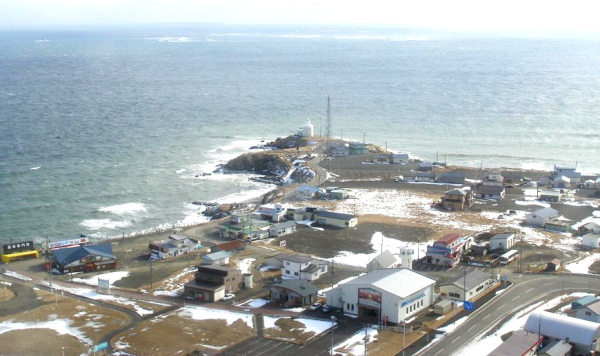The picture from yesterday’s post is Cape Nosappu:
It was another place that Will and I visited when we were on Hokkaido.
Cape Nosappu is not only the easternmost point on Hokkaido but also the easternmost point in Japan that is open to the public.
When we went there it was raining hard!
We had a hot drink in one of the local buildings and bought some souvenirs. At one point Will was doing some birding and I was dry in the car, facing the lighthouse right at the end of Cape Nosappu.

While I was in the car, a young Japanese man appeared in front of the lighthouse. He took a “selfie” of himself in front of it, but he didn’t just use a smartphone – he set up a large camera on a tripod! For some reason I found this incredibly amusing. I also felt a bit sorry for him that he seemed to be on holiday alone and had no-one to take this photo for him in the rain.
I poked my head out of the car and said:
お手伝いしましょうか
“otetsudai shimashou ka”
Can I help you?
He said:
大丈夫です
“daijōbu desu”
I’m fine
We both laughed, perhaps because of the natural Japanese tendency to laugh in awkward situations, or perhaps because the rain and wind made the whole situation highly comical.
I kept the door open anyway and an eye on the tripod just in case it blew away and I needed to leap out and save his camera like a hero.
But that didn’t happen!
I’ve had a week or so of reminiscing about holiday antics from when my brother visited. Tomorrow I’m going to change the subject, as the somewhat cryptic image today might suggest!



Is it normal in Japan to write things down posts like the ones at the entrance to the lighthouse? The writing looks calligraphic, almost as though they are haikus!
LikeLiked by 1 person
Good question. It is very normal!
You especially see Japanese written downwards on menus. I am not sure why.
One thing is clear though: with a language where each symbol represents an idea or distinct “sound”, writing vertically is more straightforward to parse than in a language like English where words must typically be consumed whole before (sometimes) even the pronunciation of the first letter can be known for sure.
As with all your comments Dad, this deserves some research on my part and a thorough write up. Now you mention it I realise that vertical writing in Japanese lends itself particularly well to discrete units. Items on a menu, warnings on a road, instructions on a wooden post… I suppose vertical writing is a “bullet-point” medium.
Or I could be thinking to much into this…
Either way, something for a series of posts later in the year!
Thank you!
LikeLike
For most of history, Japanese was near-exclusively written vertically (or sometimes sideways on shop signs etc.) There was a fair bit of right-to-left horizontal writing in the prewar period too, which confuses students no end these days, but in the present only vertical or L-R horizontal is used, with vertical predominating in your day to day novels, newspapers etc. But what amuses me is the great humanities-sciences directional divide in Japan: humanities journals are almost always published in vertical format, but the sciences generally use L-R sideways writing.
The reason is pretty simple: science needs numbers, and writing Western/Arabic numerals vertically just looks damn silly.
LikeLiked by 1 person